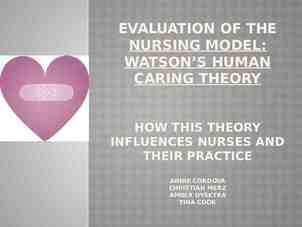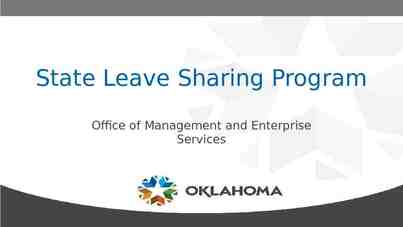Business Intelligence and How to Teach It Hugh J. Watson Terry
59 Slides2.25 MB
Business Intelligence and How to Teach It Hugh J. Watson Terry College of Business University of Georgia
Topics l Terminology, frameworks, and concepts What’s new in BI Different BI “targets” Exemplars of BI-based organizations Requirements for being successful with BI and analytics What I teach in my BI courses Using the Teradata University Network to teach BI
What Is Business Intelligence? Its roots go back to the late 1960s In the 1970s, there were decision support systems (DSS) In the 1980s, there were EIS, OLAP, GIS, and more Data warehousing and dashboards/scorecards became popular in the 1990s
What Is Business Intelligence? Howard Dresner, a Gartner analyst, coined the BI term in the early 1990s Today there is much discussion of analytics There are many BI definitions, but the following is useful
Business intelligence (BI) is a broad category of applications, technologies, and processes for gathering, storing, accessing, and analyzing data to help business users make better decisions.
Things Are Getting More Complex Source systems include social media, machine sensing, and clickstream data (Big Data) The cloud, Hadoop/Reduce, and appliances are being used as data stores Advanced analytics are growing in popularity and importance
Pervasive BI Mobile BI Big Data Predictive Analytics BI Based Organizations BI 2.0 Software Master Data Management BI in the Cloud Real Time BI BI Governance In-Memory Analytics Data Scientists SaaS Data Appliances BI Competency Centers BI Search Event Analytics Agile Text Analytics Columnar Databases Advanced Data Visualization Rules Engines Hadoop/ MapReduce Open Source BI Software
What Is Meant by Analytics? A new term for BI Just the data analysis part of BI “Rocket science” algorithms Three kinds of analytics
Descriptive Analytics What has occurred?
Predictive Analytics What will occur?
Prescriptive Analytics What should occur?
There are different “targets” for BI
A single or a few applications A point solution May be departmental Serves a specific business need A possible entry point
Enterprise analytical capabilities The infrastructure is created for enterprisewide analytics Analytics are used throughout the organization Analytics are key to business success
Organizational transformation Brought about by opportunity or necessity The firm adopts a new business model enabled by analytics Analytics are a competitive requirement
For BI-based organizations, the use of BI/analytics is a requirement for successfully competing in the marketplace.
2011 Academic Research Firms that emphasize data and analytics 5-6% Productivity Return on equity Market value
Conditions that Lead to Analyticsbased Organizations The nature of the industry Seizing an opportunity Responding to a problem
Complex Systems versus Volume Operations A distinction made by Geoffrey Moore Helps in understanding what kinds of organizations are most likely to be analytics based
Complex Systems Tackle complex problems and provide individualized solutions Products and services are organized around the needs of individual customers Dollar value of interactions with each customer is high There is considerable interaction with each customer Examples: IBM, World Bank, Halliburton
Volume Operations Serves high-volume markets through standardized products and services Each customer interaction has a low dollar value Customer interactions are generally conducted through technology rather than person-toperson Are likely to be analytics-based Examples: Amazon.com, eBay, Hertz
The nature of the industry: Online Retailers BI Applications Analysis of clickstream data Customer profitability analysis Customer segmentation analysis Product recommendations Campaign management Pricing Forecasting Dashboards
“We are a business intelligence company” Patrick Byrne, CEO, Overstock.com
Seizing an Opportunity: Harrah’s In 1993, the gaming laws changed Harrah’s decided to compete and expand using a brand and customer loyalty strategy Implemented WINet with an ODS and DW Offered the industry’s first customer loyalty program, Total Rewards
Seizing an Opportunity: Harrah’s Fact based decision making replaced “Harrahisms” Today it is the largest gaming company in the world Recently renamed Caesars
Responding to a problem: First American Corporation The bank was failing A new management team stopped the bleeding A customer intimacy strategy was implemented, Tailored Client Solutions First American
Responding to a problem: First American Corporation The business strategy was enable by a data warehouse and BI First American
Responding to a problem: First American Corporation External talent was brought in as needed Applications using VISION were developed for every component of TCS The bank was transformed from “banking by intuition” to “banking by information and analysis” First American
Let’s Answer Two Questions 1. 2. What is special about advanced analytics? What are the requirements for being a BI or analytics-based organization?
A clear business need
Strong, committed sponsorship
Alignment between the business and IT strategy
A fact-based decision making culture
Creating a Fact Based Culture Things that senior management needs to do: Recognize that some people can’t or won’t adjust Be a vocal supporter Stress that outdated methods must be discontinued Ask to see what analytics went into decisions Link incentives and compensation to desired behaviors
A strong data infrastructure
Source: Eckerson, 2011
The right analytical tools
New tools and architectures may be needed
Strong analytical personnel in an appropriate organizational structure
Knowledge Requirements for Advanced Analytics Business Domain Data Modeling
Business Analyst Uses BI tools and applications to understand business conditions and drive business processes
Data Scientist Uses advanced algorithms and interactive exploration tools to uncover nonobvious patterns in data
Business Analyst Business Domain Data Modeling Data Scientist Business Domain Data Modeling
Business Analyst Education: BBA, MBA Tools: Cognos, Hyperion Data Scientist MS, PhD KXEN, SAS Analytics: OLAP Focus: Business Scope: Departmental Neural networks Analytics Enterprise-wide Value: Exceptionally high High
Where to put the analytics team? Spread throughout the organization In a standalone unit In some form of an Analytics Competency Center
What I Teach in My BI Course Concepts, terms, and definitions Making the business case for BI Development methodology for BI Data and data warehousing BI software Interface design BI applications (e.g., dashboards) Analytics Best practices case studies Organizational issues Determining the ROI for BI Implementing BI enterprise wide Future directions for BI
Teradata University Network A premier, free online educational resource for university professors around the world who teach classes on data warehousing, DSS/business intelligence, and database. Current Membership Over 3,000 registered faculty members Representing 1,641 universities In 90 countries Thousands of students An international community, led by academics, whose members share their ideas, experiences, and resources with others www.teradatauniversitynetwork.com
Using the Teradata University Network Faculty apply for membership, and are authenticated Faculty have access to course syllabi, articles, cases, projects, assignments, presentations, software (Teradata, MicroStrategy) various datasets, web seminars, and more. Faculty have the ability to post and share their favorite content Faculty send students to TUN to access course-related materials
Resources from TUN Articles Current state of BI Business analytics Big data Future directions for BI software Understanding users value proposition Decision support sweet spot Dashboards and scorecards Dashboard design Data warehousing Data profiling Data quality Data mining primer Assessing BI readiness Business schools need to change what they teach
Resources from TUN Cases Harrah’s First American Corporation Continental Airlines Retailstore.com Catalina Marketing Norfolk Southern Railway Spokane Teachers Credit Union U.S. Xpress Videos Applebee’s Nationwide Continental Airlines BSI: Retail Tweeters
Resources from TUN Assignments 1-800 CONTACTS Genericorp Software Teradata SQL Web Assistant MicroStrategy Tableau
References Brynjolfsson, Hitt, and Kim, “Strength in Numbers: How does data-driven decision-making affect firm performance?,” Social Science Research Network (SSRN), April 2011. Cooper, Watson, Wixom, and Goodhue, "Data Warehousing Supports Corporate Strategy at First American Corporation," MIS Quarterly, December 2000. Eckerson, “Big Data Analytics,” BeyeNetwork, September 2011. Davenport, Harris, and Morison, Analytics at Work: Smarter Decisions, Better Results, Harvard Business School Press, 2010.
References Davenport and Harris, Competing on Analytics: The New Science of Winning , Harvard Business School Press, 2007. Eckerson, W. (2011). Big Data Analytics: Profiling the Use of Analytical Platforms in User Organizations. BeyeNetwork. http://www.beyeresearch.com/executive/15546 LaValle, et al., “Analytics: The New Path to Value,” IBM, MIT Sloan Management Review, 2010, http://public.dhe.ibm.com/common/ssi/ecm/en/gbe03371us en/GBE03371USEN.PDF
References Moore, Crossing the Chasm: Marketing and Selling High-tech Products to Mainstream Customers, HarperBusiness Essentials, 2002. Moore, Inside the Tornado, HarperBusiness Essentials, 2004. Watson, “Business Analytics Insight: Hype or Here to Stay?” Business Intelligence Journal,” March 2011. Watson and Volonino, “Harrah’s High Payoff from Customer Information,” Printed in Eckerson and Watson, Harnessing Customer Information for Strategic Advantage: Technical Challenges and Business Solutions, TDWI, 2000.
References White paper, “The Current State of Business Analytics: Where Do We Go From Here?” Bloomberg BusinessWeek Research Services, 2011. Williams, “Assessing BI Readiness: A Key to BI ROI,” Business Intelligence Journal, Summer 2004.
Dr. Hugh J. Watson is a Professor of MIS and a holder of a C. Herman and Mary Virginia Terry Chair of Business Administration in the Terry College of Business at the University of Georgia. Hugh has authored 23 books and over 150 scholarly journal articles. He is a Fellow of the Association for Information Systems and The Data Warehousing Institute and is the Senior Editor of the Business Intelligence Journal. For the past 20 years, Hugh has been the consulting editor for John Wiley & Sons’ MIS series. He can be contacted at [email protected]
































































